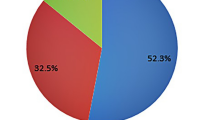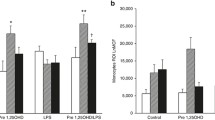Abstract
We carried out a comparative clinical and immunological examination of newborns whose mothers were at risk of infectious inflammatory diseases. Umbilical blood cell phenotype was evaluated by flow cytofluorometry. ROS level was evaluated by chemiluminescence intensity. Spontaneous production of ROS and phagocytic activity of cells in the whole umbilical blood was reduced in newborns born after complicated pregnancy. Low immunoregulatory index indicating changed CD4+/CD8+ ratio and low percentage of natural killer cells were observed in children with manifestations of bacterial infection. ROS production by isolated granulocytes and the effects of PI3K and p38 MAPK (kinases involved in the regulation of activity of NADPH oxidase responsible for the production of ROS) in the risk group infants differed from the corresponding parameters in the control group. The results indicate shifts in the phagocytosis system, immune status, and the receptor-conjugated regulatory systems of ROS generation by granulocytes in newborns at risk of infectious inflammatory diseases.
Similar content being viewed by others
References
M. V. Degtyareva, N. N. Volodin, K. K. Bakhtikyan, et al., Med. Immunol., 2, No. 1, 69–76 (2000).
V. G. Safronova, N. K. Matveeva, V. N. Mal’tseva, et al., Byull. Eksp. Biol. Med., 140, No. 8, 173–176 (2005).
K. Q. Chen, P. Iribarren, W. H. Gong, et al., Cell. Mol. Immunol., 2, 241–252 (2005).
U. H. Chudgar, G. W. Thurman, and D. R. Ambruso, Pediatr. Blood Cancer, 45, 311–317 (2005).
A. Davoren, K. Saving, J. G. McFarland, et al., Transfusion, 44, 1041–1046 (2004).
S. K. Kim, S. E. Keeney, S. K. Alpard, et al., Pediatr. Res., 53, 132–136 (2003).
H. Komatsu, K. Tsukimori, K. Hata, et al., Early Human Develop., 65, 11–19 (2001).
O. Levy, K. A. Zarember, R. M. Roy, et al., J. Immunol., 173, 4627–4634 (2004).
D. Luo, K. O. Schowengerdt, J. J. Stegner, et al., Pediatr. Res., 53, 859–864 (2003).
T. Mikami, M. Eguchi, H. Kurosawa, et al. Med. Electron. Microsc., 35, 96–101 (2002).
M. Nybo, O. Sorensen, R. Leslie, et al., Arch. Dis. Child. Fetal Neonatal Ed., 78, F129–F132 (1998).
L. Pollak, T. Hanoch, M. J. Rabey, et al., Neurol. Sci., 26, 324–329 (2005).
F. R. Sheppard, M. R. Kelher, E. E. Moore, et al., J. Leukoc. Biol., 78, 1025–1042 (2005).
L. Stephens, C. Ellson, and P. Hawkins, Curr. Opin. Cell. Biol., 14, 203–213 (2002).
J. S. Wang, H. Chen, and Q. R. Zhu, World J. Gastroenterol., 11, 3582–3585 (2005).
Author information
Authors and Affiliations
Corresponding author
Additional information
__________
Translated From Byulleten’ Eksperimental’noi Biologii I Meditsiny, Vol. 142, No. 9, Pp. 304–308, September, 2006
Rights and permissions
About this article
Cite this article
Safronova, V.G., Matveeva, N.K., Mal’tseva, V.N. et al. Generation of reactive oxygen species by umbilical blood cells and immune status of newborns at risk of infectious inflammatory diseases. Bull Exp Biol Med 142, 333–337 (2006). https://doi.org/10.1007/s10517-006-0359-x
Received:
Issue Date:
DOI: https://doi.org/10.1007/s10517-006-0359-x




